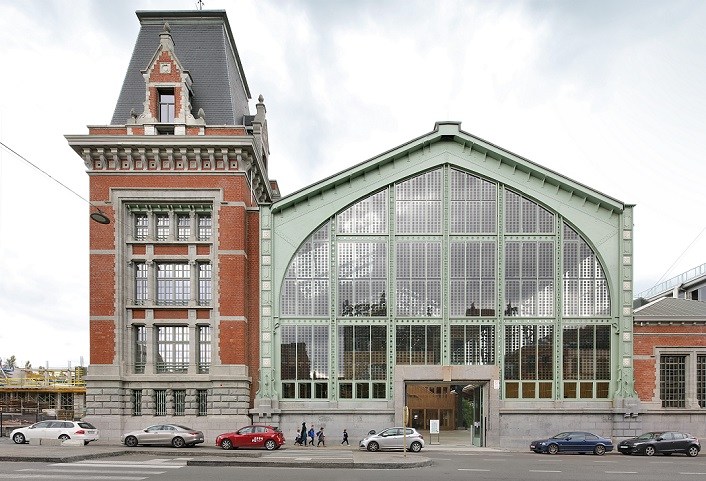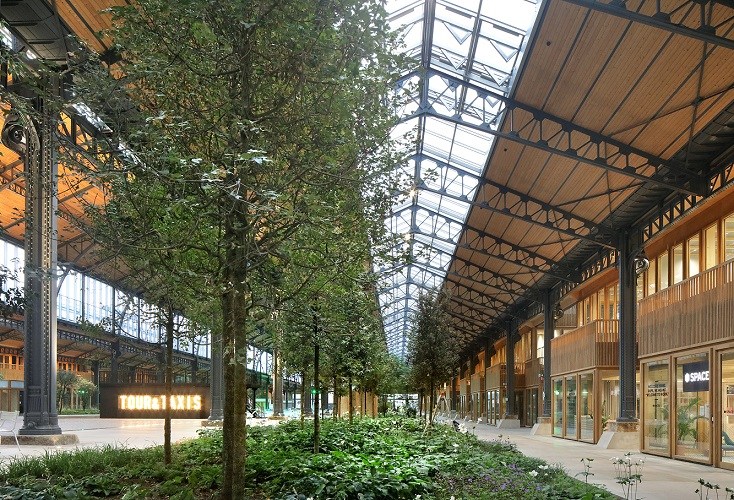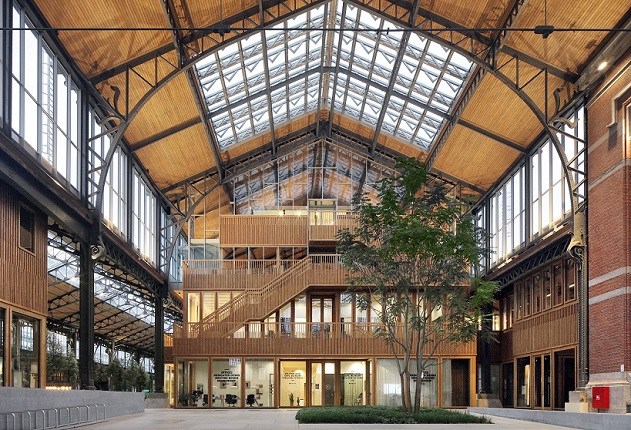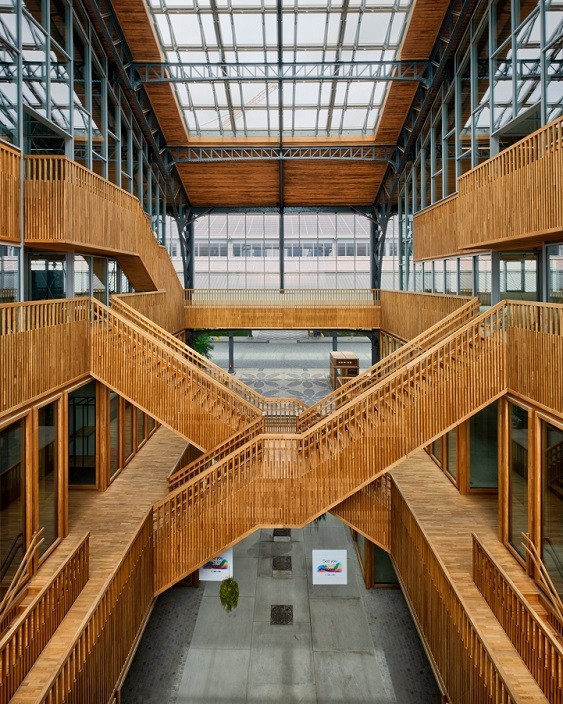A generation ago, the Gare Maritime in the Tour & Taxis industrial site was an abandoned wasteland. It is now a model for urban renewal and sustainable architecture. Its reopening offers a new vision for Brussels, as Angela Dansby reports
The vast Tour & Taxis industrial complex along the Brussels Canal was once Europe’s largest freight train station for international goods. But by the 1980s, the Gare Maritime, as the goods station was known, lost favour, became obsolete and then abandoned.
Today, however, it has been renovated and reborn as a vision of sustainable redevelopment. Completed architecturally in 2020 and fully opening by October 2021, the Gare Maritime is almost a covered city: a 45,000-square-metres footprint with a main street, boulevards, squares, gardens and trees. It is probably the most exciting architectural project in Brussels of the past decade.
How did it come about? First, a little history. Between 1907 and 1986, international goods would arrive at Tour & Taxis by water, rail and land. Customs and excise duties were collected onsite and goods were stored in warehouses before redistribution (a few of these customs functions still take place at nearby offices). But as they fell into disuse, the Port of Brussels and the railway companies sold the Tour & Taxis buildings, including Gare Maritime, in 2001.
It is now owned by real estate giant Extensa, whose CEO Kris Verhellen, had bold ambitions for the site. Verhellen says. “Having an exciting story and unique experiences is what it’s all about,” he says. “Early in the 20th century, Belgium was at the forefront of the industrial revolution and Gare Maritime was made with ambition for more. Today, we have a different ambition of preserving the building for future generations. The Grand Old Lady now has a new lease on life.”
Reimagining the site
Verhellen says it was the US television show ‘Ally McBeal’ (1997-2002) that inspired the creation of loft-style offices there. It started a trend that led to Extensa making Gare Maritime a creative hub, getting forward-thinking companies “over the canal” to the site. “Gare Maritime was multimodal for the distribution of goods in the old economy but now it’s a multimodal platform for the distribution of ideas in the new economy,” he says.
But Verhellen also recognised that the architecture of Gare Maritime needed to be reimagined. And that led him to Rotterdam-based Neutelings Riedijk Architects. “They respected the ‘Grand Old Lady,’” he says. “I remember former co-founder Willem Neutelings saying, ‘your cathedral is already there.’”
Michiel Riedijk, principal architect at Neutelings Riedijk, says the plan was to retain the existing urban context and the building structure in a natural way. “The open public space in the middle of the ‘city’ is subject to the changing of the seasons visually and climatically, mimicking an open-air experience indoors,” he says.
That meant retaining the steel frame and historic buildings within Gare Maritime, like the Maison de la Poste, timber roofs, Belgian bluestone (pierre bleue belge) from train platforms and original cobblestones on walkways. For example, the steel columns were coated with fire-resistant paint, the roofs sandblasted and the cobblestones flattened out for ease of walking. The bluestone from Hainaut, rare because of its local production, was cut into pieces to fit under structural columns for greater visibility.
“We got original plans from 1902 for the building from universities and tried to restore as much as possible in the most authentic way,” says Verhellen. “Some technical adaptations were required – for example, glass roofs for light inside gardens and smoke evacuation – but we retained everything possible while creating this covered city quarter.”
They also needed lightweight material to sit on the original steel frame as it could not take the weight of concrete. European oak and pine wood was the perfect solution, cross-laminated for better structural rigidity. “We could prefabricate new building pieces and fit them together like Lego under the historic roof and steel frame,” Verhellen says. “This allowed us to maintain the heritage of Gare Maritime.”
Light and sustainable
The result is a gorgeous, light-filled, sustainable building with three larger and four smaller halls plus 10 larger and 12 smaller pavilions. The wooden pavilions – linked by visible timber stairways that intersect with dramatic effect – create a network of “boulevards, streets, squares and gardens.”
Gare Maritime has both private and public domains, including 12 offices, meeting and event spaces, about 20 shops, 10 retail kiosks, themed gardens with tall trees and a 2,500-square-metre food court. Eight squares feature original cobblestones rearranged in beautiful mosaic patterns by the Brussels-based visual artist Henri Jacobs.
Maison de la Poste – a former post, telegram and telephone office – provides elegant meeting spaces and a rooftop corporate cinema for rent. “Maison de la Poste was like the Amazon and Microsoft of its time,” says Verhellen. “It’s a castle on its own with huge rooms that each have their own identity.”
Verhellen likens the Gare Maritime to London’s Covent Garden but it is so much bigger – equivalent in size to more than six football pitches – and with less commercial focus. “We didn’t make it a shopping centre so as not to promote consumerism,” he says. “Its long-term strength is the new vision of a circular economy and the opportunity to expand an economy is itself a sustainable concept.”
Extensa carefully selected its tenants, including Publicis Groupe, Accenture, Universal and B/S/H/, because they are also mindful of sustainability. Their interiors match this concept. B/S/H/, for example, has a new-generation showroom of cooking and kitchen appliances, which is perfectly located next to the food hall. “For those who embrace Gare Maritime, it’s heaven,” Verhellen says, whose own operations team works in the Tour & Taxis complex. “There will be trade and consumption at Gare Maritime but not consumerism.”
The elaborate renovation took four years. Exterior parts are still being built out, including five apartment buildings behind the Gare Maritime and a pond and park in front of it. The latter are expected to be completed by summer 2022.
New European Bauhaus
The Gare Maritime concept – carbon and energy-neutral, fossil fuel-free – also ties in with the New European Bauhaus sustainable architecture initiative promoted by the European Commission this year.
As Europe’s biggest timber construction project, Gare Maritime has about 10,000 cubic metres of carbon dioxide-absorbing material (using timber rather than concrete in the construction saved an estimated 3,500 tonnes in COz emissions.)
It also produces more renewable energy than it consumes. Its roofs have 17,000 square metres of solar panels – indeed, its solar energy can be shared with the Molenbeek neighbourhood in case of surplus. It can produce 3,000 megawatts of electricity a year, which is enough for 850 households. In addition, glass windows in bookend archways and on upper levels contain solar cells.
“Gare Maritime exemplifies, without intention, the new European Bauhaus,” Riedijk says. “Extensa wanted office space of the future geared towards the wellbeing of people in the building. The historic structure drove our creativity and sustainability constraints led to other modes of execution.”
For example, the giant roof allows for rainwater collection. Two large tanks supply water for the gardens and toilets. Geothermal pumps heat pavilion interiors and the floor of the food court. However, there is no heating in the open, main hall so a coat may be needed there during winter, Verhellen says.
Pixelized, six-metre-high windows on the upper levels help keep the sun out so the building does not overheat. With intelligently tinted, remote-controlled glass, the windows change colour to act like sunscreens while maintaining transparency so people can still see outside.
No surprise, Gare Maritime won its certification with BREEAM, a rigorous sustainability assessment method for buildings and infrastructure that requires not only green design but also user-friendly aspects like being close to public transport (the Yser metro is an eight-minute walk, while a tram stop on the Rue Picard is forthcoming), responsibly collecting waste, having visible staircases and providing a healthy environment.
The building has also won numerous awards for sustainability and architecture, including the prestigious Europa Nostra Heritage Award 2021, Belgian Building Award 2021 and nomination for the Mies van der Rohe Award 2022.
Verhellen says the Gare Maritime is the largest circular economy project in the world. "Sustainability was a choice out of our own interests; it is an essential quality of any project that we do,” he says.
Food magnet
However, the main attraction, as far as the public is concerned, could be the food court. It will feature a Victoria beer bar, 10 restaurants representing Belgium’s gastronomic scene, indoor terraces, and retail stands with original, creative and healthy items. It will be sustainable here too: reducing food waste and using recyclable materials.
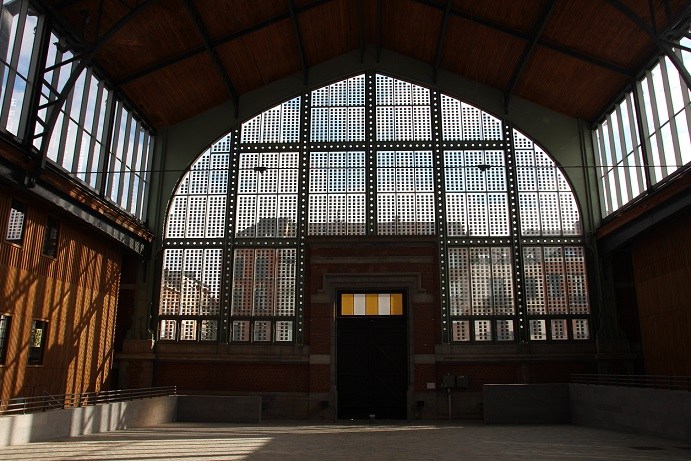
Credit: Angela Dansby
“The food hall will be a vibrant destination for the public because we have such a rich food and beverage culture in Belgium,” Verhellen says. “We will work with famous chefs to bring gourmet offerings for good value. Ingredients will be locally sourced with short-chain production. Everything must tell a story.”
The indoor food market is set to be the largest in Europe, according to brewing giant AB InBev, which is running it as a joint venture with Extensa. It is slated to open by early October, after COVID-19 postponed the original launch date.
Also connecting Gare Maritime to the public was a competition in collaboration with the city of Brussels to name the building’s streets, squares and kiosks. Names selected from public suggestions reflect modern Belgian icons like cuberdon and speculoos as well as goods that were once stored on site.
“Gare Maritime presents an opportunity for a unique experience that can touch people emotionally,” Verhellen says, suggesting it might become both a local and tourist attraction, bringing more international visibility to the city. “Brussels has not had a building with a wow factor since the Atomium in 1958. It needs something new and out of the ordinary.”
By Angela Dansby


